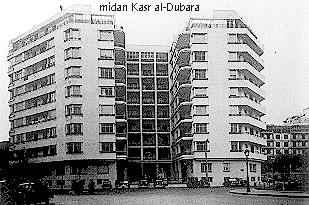
|
|
|
|
|
Cheers to our "talented" literature prize awardee. Your pain his gain !!!
|
|
|
EGY.COM - GARDEN CITY
|
|
|
|
|
Cairo Times, 24 June 1999 |
Come July 5th motorists commuting to work via Kasr al-Dubara will notice an assemblage of dapper ladies and gentlemen laying wreaths at the foot of Simon Bolivar's statue located at the square by the same name.
Only now we no longer call the veteran district by its original name but tend to lump it with Garden City in spite of the fact that the latter technically starts three blocks to the south. Hmmm... wouldn't it be a shame if we also started referring to Heliopolis as Nasr City!
The name Simon Bolivar itself is relatively new. Ever since it was mapped out in the 1880s the square had been known as Midan Kasr al-Dubara reference to a nearby viceregal palace. It was only when the statue of Simon Bolivar was unveiled on 11 February 1979 that the name change occurred. And even then we couldn't get it right since one of the street signs mistakenly refers to the square as Simone Bovoir, a misspelled reference to the celebrated French female author.
Attending the inauguration of the revamped square were two high powered Latin American delegations headed by Venezuela's first lady-Dona Blanca Rodrigues de Perez-who arrived especially for the occasion. After all, the statue had been a gift from her oil-rich homeland to Sadat's Egypt.
Since that eventful day and every 5th of July thereafter, representatives from six Latin American countries-Venezuela, Panama, Colombia, Ecuador, Bolivia and Peru-congregate to honor the memory of their shared hero. It was the Caracas-born Bolivar (1783-1830) who had led these nations to independence from Spain early last century.

While the 500 Kg, 2.3m high bronze statue is attributed to Venezuelan sculptor Carmelo Tabaco, the accompanying pedestal is the work of fellow countrymen Manuel Silveira Blanco. Another statue commemorating yet another Latin American nationalist-Jose de San Martin-can be found in Mohandessine next to the Shooting Club. Martin was responsible for the independence of the southern part of the South American continent.
As South America struggled for independence from Spain, Egypt was slowly modernizing itself under Viceroy Mohammed Ali and his descendants. Two of them, Ibrahim and Ismail, were responsible for the creation of Kasr al-Dubara. If Ibrahim turned the marshy lands next to the Nile into orchards and gardens, it was his son Ismail who traced and created several of Cairo's new districts.
At Kasr al-Dubara Ismail built several palaces. Two of them overlooked Midan Kasr al-Dubara: Kasr al-Aali (now monstrous Mogam'a Building) and Kasr al-Walda Pasha (now a series of buildings including Shepherds Hotel). A third palace was commissioned by his granddaughter Princess Nimet Kamal al-Din which she later donated to the Foreign Office. Standing opposite the Arab League with half of its garden already axed, the palace is crying out for attention before it crumbles into a mass of plaster and stone.
After Egypt's royals came Cairo's glitterati. Fin de siècle social pages abound with references to their Kasr al-Dubara villas and mansions especially during wedding season. It is there that Egypt's Greats were regularly consecrated. Indeed, the funeral of banker Suares in the 1890s did not differ much from that of a Pasha-politician in 1950 or an incumbent minister in 1998, for all three corteges invariably led to the clogging of traffic at the prominent Midan. (grand funerals still take palce at Midan Simon Bolivar thanks to the abutting Mosque of Sheik Omar Makram which replaced that of Sheik al-Abit).
After the glitterrati came the hotels and embassies. First among the big names within the hospitality industry to grace Midan Kasr al-Dubara was the Semiramis in 1908. Built in phases, it occupied most of the block between the Midan and the Nile.
Mid-century saw the arrival of the Shepheards, a successor of the legendary hotel torched to the ground (in another part of Cairo) during the burning of Cairo in January 1952.
It was in the palatial mansion of merchant Emanuel Casdagli, which directly fronts the square, that the United States moved its legation during the interwar period. The building miraculously survived and is today occupied by a government school whose sole purpose it seems is to add a new dimension to the word uglyfication.
 Right behind Villa Casdagli was Villa Cozzica. Leased to the Weimar ambassador, it was there that Josef Goebbels, while on a short visit to Egypt, gave a poorly-attended soirée in April 1939, a few months before WW2.
Right behind Villa Casdagli was Villa Cozzica. Leased to the Weimar ambassador, it was there that Josef Goebbels, while on a short visit to Egypt, gave a poorly-attended soirée in April 1939, a few months before WW2.
Also fronting the square was a ladies-only tennis club. This was transposed in the late 1940s with a U-shaped apartment building designed by one of Cairo's leading architects--Antoine Selim Nahas--for account of al-Chams Real Estate Company. The arrival of "al-Chams" signaled that a burgeoning Egyptian bourgeoisie had come to replace Kasr al-Dubara's fading Levantine aristocracy. The rest is history.
|
|
|
|